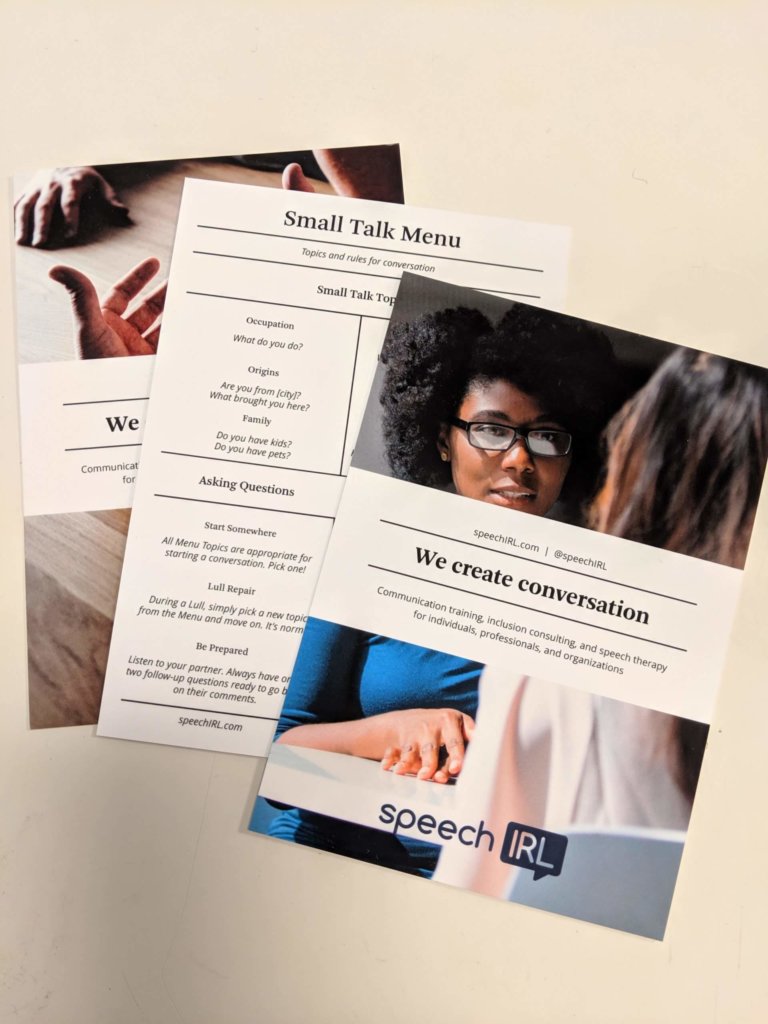If communication topics were songs, Small Talk would be in our Top 5 Greatest Hits at speech IRL. We hear all kinds of complaints about how pointless small talk is and that it’s a waste of time. So, some of our most chagrined clients are surprised to find out that small talk is actually a means to an end—and understanding that purpose is often what solves the small talk problem. Ironically, while it is one of the most universally-loathed forms of communication, it is one of the most straightforward skills to teach.
Take this client for example:
“Any plans this weekend?”
“Yeah.” He sighed. “I’m going to California. My girlfriend’s cousin is getting married. I’ve met a bunch of her family, they’re fine…it’s just the whole conversation thing is so exhausting. Like even though I’ve met them, we just have to be together for all those hours, and I never know what to say. It’s so awkward.”
We had already finished the session, but I wanted to assuage his stress. “Oh yeah, that’s a thing. You know there’s a formula for that, though, right?”
He bolted upright. “What?”
“Yeah, here.” I grabbed a piece of paper and sketched out a few words. “Here you go.”
He stared at it, in a blend of relief and anger.
“Holy shit. Why the f--- did no one teach me this in middle school???”
Conversation is an art, but there is an awful lot of science, or method, behind it. Small talk is in fact the most methodical form of conversation. I’ve written previously about the high-level principles of successful conversation, where small talk is a critical element. In this post, I’ll outline exactly what small talk is, how to do it, and how it relates to the introvert’s saving grace: Medium Talk.
Why small talk?
Most people find small talk stilted and surface-level, which it is, by design. However, that does not mean it’s entirely pointless. The purpose of small talk is to enable two strangers or acquaintances to engage in a safe, predictable conversation that ideally leads them to a more meaningful, enjoyable topic. Small talk is a structured social ritual that lets us feel each other out to determine if we’re a good match for a deeper conversation. The basic three-step process of small talk is to pick a topic, provide detail, and pass the turn. Often coming up with topics is one of the hardest steps, so when you know you are going into a small talk situation, it’s a good idea to come prepared with a list of conversation go-tos.
Small Talk Topics
The following are a list of topics that are used to engage in small talk in the English-speaking United States.*
- The weather: “It’s a beautiful day!”
This is a classic topic because it is a guaranteed shared experience. Even if you’re standing in an elevator with a stranger for 3 minutes, you know that both of you are presently experiencing the same weather conditions, and can relate to each other on this matter.
- Origins: “Where are you from? / Did you grow up here? / How did you come to [city]?”
Everyone has a story, and our place of origin is part of that story. Whether a person has spent their whole life in one place, or moved from A to B, there’s a story either way.
- Occupation: “What do you do? / Where do you go to school?”
In the United States, work and/or studies are often closely tied to personal identity, and are how we spend a significant portion of our time.* This is an especially important opening question at professional networking social events.
- Hobbies and interests: “What do you do for fun?”
- Popular media (books, TV shows, movies): “Have you watched Tiger King?”
- Sports [note: not everyone is fluent in Sports, myself included, but this is a very accessible topic for a lot of people and a quick bonding opportunity for those who do enjoy it]
- Travel and holiday plans: “What did you do over the break / do you have any summer holiday plans?”
- Current non-political events: “Have you been watching the Olympics? / Did you watch the SpaceX launch?”
- Current shared surroundings: “Have you been here before? / How did you find out about this place?”
- Family: “Do you have kids? / How did you meet your partner?”
This question is best used for later on in a small talk conversation, once some familiarity has been established, or if there has been explicit reference to kids/partners already.
2020 BONUS
- Pandemic / general 2020 experience: “How are you handling working from home? / How has it been for the kids? / Any new quarantine hobbies? / What catastrophe are you betting on for August?”
*Different cultures have different rules about what is and is not an acceptable small talk topic. For example, it is considered unusual or even rude to ask people about their occupations in some cultures/languages. If you’re new to a cultural-linguistic context, ask some native speakers about the most common conversation openers.
Starting and Maintaining the Conversation
Pick a topic from the above list and ask a question. No need for a fancy intro or smooth segue. “So, have you been here before?” “So, what about you? What do you like to do for fun?”
The person who opens the conversation plays the first “card”, by laying a topic on the proverbial table. Once a card has been played / topic has been provided, the other conversationalists are responsible for taking turns and contributing to the flow of that round.
There are two key rules to keep the round going: you must provide detail, and pass the turn.
Providing Detail
This is essential because it gives your conversational partner(s) content to build on and potentially find a connection. One-word answers that don’t provide any detail will kill the conversation round.
Example of a conversation-killer:
“What do you like to do for fun?”
“Oh, whatever. Netflix mostly.”
“Oh yeah? What kind of shows do you like?”
“Eh, whatever’s on. I’ll kind of watch anything.”
“Seen anything good lately?”
“Mostly reruns of old shows. Nothing too exciting.”
Example of a conversation-cultivator:
“What do you like to do for fun?”
“Honestly I mostly stream shows.”
“Oh yeah? What kind of shows do you like?”
“Right now I’m watching a lot of sci-fi. I just finished Picard, and I’ve just gotten into the Expanse which is really good so far. Are you into sci-fi?”
Pass the Turn
Pass the conversation turn back to your partner(s) by asking a question. In the early turns of small talk, turns should be passed back and forth relatively quickly. The purpose here is to determine if the topic at hand is a good one for getting into “real” conversation, or if you should abandon it and quickly move onto something else to find common ground. Here’s the magic formula we mentioned at the beginning of this post:
- Answer the Question
- Provide 1-2 Lines of Detail
- Pass The Turn
In the above example, if the turn is passed back to the original speaker and it turns out they also enjoy sci-fi, this can now become a Real Conversation discussing a shared love of sci-fi. However, if the original speaker says they do not like sci-fi, then a new small talk topic should be selected. You could ask about other genres of TV, or move onto something entirely different like holiday preferences or quarantine habits.
Many small talk topics are sufficient for at least a few turns of back-and-forth. With each turn, the speaker should provide a little more detail and take a little more time, so that the conversation turns gradually become more robust and meaningful. If you have a particularly relevant story or comment, it can be appropriate to take a longer conversation turn once you are 4-6 turns in. The key is to always end by giving the turn back to your conversation partner(s), especially if you have taken a longer turn yourself. “So yes, that was my first experience with camping. Can’t say it made me want to do it again. Have either of you gone on extended outdoor trips before?”
Handling a Lull
Perhaps the second-most dreaded moment in small-talk situations after finding a topic is handling a lull. It is normal for natural dead-ends to occur in small talk conversations. This can be accompanied by an awkward silence that sometimes drives people to check their phones or make an excuse to use the bathroom.
The way to handle a lull is to simply pick a new topic and toss it out there. As with initiation, there is no need for a smooth transition. Everyone is uncomfortable and awkward during a lull, so as long as the topic is safe and appropriate, all other conversation parties will be relieved that someone has taken the step to eliminate the lull. Silence is worse than conversation that moves forward, so just pull out a new topic and move it forward!
Ending or Transitioning to Medium Talk
Ideally, a small talk conversation will lead participants to a topic that is enjoyable enough for Medium Talk. The basic rules of turn-taking and question-asking apply for both small and medium talk, but medium talk has more nuance and significantly more topic flexibility (more to come in our next post!).
Unfortunately, sometimes a pair of perfectly nice and interesting people exhaust the entire small talk topic list without finding anything meaningful to talk about. That’s OK! In a situation where you have given your best effort in a conversation and realize it’s time to move on, it is fine to End the Conversation.
To end a conversation, be explicit, cheerful, and decisive. Tell the person that you are leaving, and thank them for the conversation, or some other kind of complimentary acknowledgment of your time together. If it feels awkward to interrupt the conversation mid-stream, you can make an excuse as to why you need to leave. “Oh, I need to step away, I need to say hi to that person / head home to the babysitter / use the bathroom / help someone out. Great meeting you!”
Summary
- Introduce yourself: “Hi, I’m Katie.”
- Ask an opening question from the Small Talk Topic Menu
- Ask follow-up questions
- Provide robust details when answering questions
- When a lull occurs, pick a new topic!
If memorizing blog posts doesn’t feel very practical to you, we have Small Talk Menus available for free. Our Small Talk Menu lists all the small talk topics and key mechanics (asking questions, providing details) on a 4x6in postcard. Simply email us with your name, mailing address, tell us you want a postcard, and then check your mailbox!
Looking to learn more about communication basics and building communication confidence? Check out our online Mindful Communication course beginning Monday, August 3rd.


